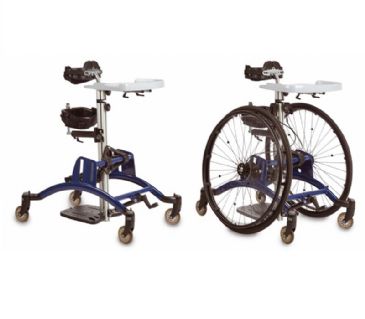 Written by Mike Price, OT
Written by Mike Price, OT
When choosing any assistive device for your child, you’re not looking for a one-size-fits-all solution. Your child is unique, with unique needs; plus, your child is growing and changing! There are several design options available, and each of the pediatric standers on our list has valuable features and benefits.
Best Overall Choice:

1) Rabbit-Up Pediatric Stander
View ProductThe Top 5:
Our list of the best pediatric standers starts with the Pediatric Adjustable Up-Rite Stander Frame from Prime Engineering. Designed by therapists, this standing frame provides mid-line positioning support.
If your child does not require therapeutic or corrective positioning, this maintenance device allows for appropriate weight-bearing and full upper body and arm use. The height, knee pads, and heel block are all adjustable, and they can be ordered in three sizes with weight capacities ranging between 200 and 250 pounds.
This stander frame comes with one single and one double comfortable cotton body support straps. Tools are not required to adjust the stander for the perfect fit. It has dual side posts for front and rear access and it can be ordered with casters on the base.
For kids who don’t need corrective positioning, the mid-line support of this stander does a great job facilitating proper weight-bearing and use of the upper body and arms. If you need a pediatric stander that is versatile and comfortable for a user that has some mobility and upper body strength and control, this is a great choice.
EasyStand’s original Evolv Sit To Stand Standing Frame Packages made our list at number 4. The 2 sizes and 4 default packages make ordering easier, and optional additions make them customizable. Each package has a 3-point system that includes knee pads, seat, and chest pad.
Whether you need the Minimum, Moderate, Maximum, or Mobile Maximum configuration, these standing frames facilitate supportive self-transitions from sitting to standing. They are easily adjustable to create the perfect fit and create an environment conducive to improved circulation, muscle tone, and bone density.
The Evolv frame packages have been featured in many articles, including How to Choose the Best Pediatric Stander. For a super easy ordering experience and enough sizes and packages to meet most any need, whatever model is best suited for your child will facilitate longer periods of standing to maximize the benefits of being upright.
At number 3 on our list of best pediatric standers is the KidWalk II Dynamic Mobility System by Prime Engineering.
This assistive device simulates a natural gait, promoting independence and exploration for children with mobility limitations. It is considered one of the best gait trainers on the market, overcoming movement limitations of most other gait trainers. Its large mid-wheel design allows lateral weight shift, upper body rotation over the pelvis, and upper extremity freedom of movement.
This system comes standard with single adjustment pelvic pads that support hip positioning, adjustable hip and chest supports, auto-centering pelvic guides, vertical weight relief, lateral weight shift, angle adjustment mast, wheel locks, quick release wheels, anti-tippers, adjustable axle padded seat, and light up rear casters. The frame comes in two pieces so it is easy to break down for transport.
If you are seeking a pediatric stander for kids ages 5-12 that is also a gait trainer and will encourage independent movement, choosing the KidWalk II will open up opportunities for mental and physical development through self-initiated hands-free exploration.
The Zing Pediatric Multi-Positioning Stander Packages from EasyStand come in 2 sizes and 4 styles, 4 frame colors, and 5 patterns of hygienic covers.
The products in this system are easy to order, configured with predetermined support systems and default sizes. The Zing packages, which include Vertical, Tilt Table, Prone, and Multi-Positioning Support at minimum, moderate, and maximum levels, are all designed to be very simple to operate.
Their sizing and adjustability, along with multiple functions and support options, adapt as your child grows and develops, and the adjustments don’t require any tools. They are popular with schools and therapy centers since they are so easily adapted to a user’s needs.
If you want a whole package that will meet all of your child’s needs with predetermined configurations and sizing, the multi-featured Zing Pediatric Multi-Positioning Packages delivers. There is a package to address any level of positioning support your child needs, allowing for more active engagement with the environment.
Topping our list of best pediatric standers is the Rabbit-Up Pediatric Stander by R82. It can accommodate children in a prone or standing position, and is set up to allow them to move independently, explore the world, and enjoy more peer interaction.
Available in 4 sizes, the Rabbit-Up accommodates children from 1 to 18 years old. It has an easy-to-use angle adjustment center bar to get the best standing position. The user operates the wheel locking system to ensure secure transfers. The driving wheels can be ordered in a variety of sizes and they are easily mounted with a quick-release mechanism. Accessories are easily mounted to slots in the center bar. The standing position helps your child enjoy a new level of mobility, fostering independence and connections with peers.
The stander requires the engagement of muscles, bones, and joints that can build muscle mass and increase range of motion in addition to developing motor skills. If you are seeking a pediatric stander that provides the ultimate in independence and mobility for your child, the Rabbit-Up is a good choice. It promotes musculoskeletal, motor skills, and social skills development, while opening up the world for new adventures.
Each of the pediatric standers on our list provides support to get children standing so they can have access to all the benefits that come from being upright. There are many levels of mobility, and regardless of your child’s mobility challenges, this list contains at least one appropriate assistive device that will be a good fit. The Rabbit-Up claimed the top spot on our list for its adaptability, age range of users, ease of use, and most of all the independence it provides for kids who are able to take advantage of the independent movement this device provides.
When choosing a pediatric stander, questions to ask include:
A self-propelled model provides a child who can stand the opportunity to move independently. Generally, mobile standers have large wheels that are engaged like they would be on a wheelchair.
If your child cannot stand at all, a passive stander is the best choice. The child can move with assistance from a caregiver, but this design is for children who can’t move on their own.
A child who has good head and neck control can use an upright pediatric stander to attain a fully upright position.
For a child who doesn’t have good head and trunk control, a supine stander provides for semi-reclined positioning.
There are pediatric standers that allow you to move between upright and supine positions.
There are functional supports available with pediatric standers to assist children with low muscle town or limited limb control. These available supports include foot loops, footrests, chest straps, body harnesses, chin rests, headrests, and hip guides. These padded aids are usually height adjustable and help keep your child upright with comfortable support tailored for individual needs.
For home use, the only considerations are positioning and mobility. However, other factors come into play if a pediatric stander will be used at school. At home, a caregiver will be the main person who is with the child using the stander.
At school, a pediatric stander can be used as a tool for learning and socialization. When put into service as a learning and socialization tool, additional factors come into play. One feature that is very useful at school that wouldn’t make as much of an impact at home is a “shadow tray,” which can be used as a desk or for holding books or other school supplies, or as a meal tray.
For an independently mobile child, the ability to move from one place to another with the assistance of a stander will positively impact cognitive, developmental, and social skills. If a child is independently mobile, consider a stander offering additional features. Moving independently in the school or daycare setting will multiply a child’s social, developmental, and cognitive gains.
Since toddlers to teenagers who have finished growing can benefit from pediatric standers, there is a wide range of size options among the various product designs.
Height adjustability and weight capacity will significantly influence your decision. The smallest pediatric standers often come in bright, fun colors and are created to be more appealing for younger kids.
It’s common for pediatric standers to be adjustable enough to accommodate elementary and middle school-aged kids. For teenagers who have outgrown traditional pediatric standers, there are models that can comfortably support adolescents who have reached their full adult height.
Pediatric standers assist children with limited mobility by supporting kids who are unable to maintain an upright position on their own. Also known as standing frames, pediatric standers allow children to spend a significant amount of time in an upright position. There are many benefits to standing for children who have limited mobility. These include improved muscle strength, endurance, bone density, digestion and elimination, urinary function, hand use, sleep, and self-esteem that comes from social interaction when a child can stand alongside peers. Time spent in a pediatric stander can also prevent bone fractures, reduce leg spasticity, minimize hip problems, and prevent pressure sores from developing.
Any child who cannot stand independently can benefit from a pediatric stander. These can include children with spinal or head injuries or conditions such as cerebral palsy, spina bifida, muscular dystrophy, and multiple sclerosis. The need for standing is well-established, and getting kids upright has multiple therapeutic and social advantages.
Pediatric standers come in several designs, and they can carry some hefty price tags. A pediatric stander is considered to be Durable Medical Equipment, and is categorized as Complex Rehab Technology. Medicaid will pay for medical equipment when it is determined to be medically necessary, cost-effective, and meets its strict definition of durable medical equipment. To be covered by Medicaid or other insurance, a prescription and demonstration of medical necessity will need to be a part of the application for coverage.
Standing is an important part of good health. In fact, home-based standing programs should include 30 minutes of standing 5 times a week for a positive impact. Although the designs and features vary, each of the pediatric standers on our list is a top-quality assistive device that will help your child at home, school, or in a therapeutic environment to be more independent and engaged while optimizing physical wellbeing and event social skills.

Co-Founder of Rehabmart and an Occupational Therapist since 1993. Mike has spent his professional career working in multiple areas of Occupational Therapy, including pediatrics, geriatrics, hand therapy, ergonomics and inpatient / outpatient rehabilitation. Mike enjoys writing articles that help people solve complex therapeutic problems and make better product choices.